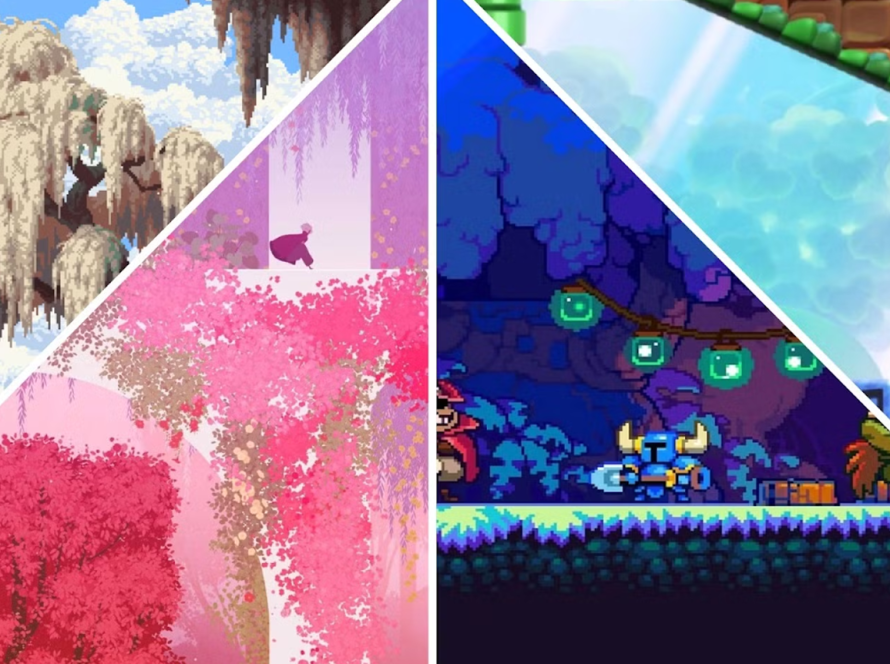Overall, tilemap is considered one of the indispensable elements in the realm of 2D game development. If you find yourself unclear about this aspect, let’s delve into the details through the article below:
What is tilemap?
A tilemap is a grid of tiles used to create maps for a game. Each cell in the tilemap represents a specific element in the game, such as terrain, objects, items and more.
By using a tile map, you can easily and flexibly design game levels or landscapes. You can arrange tiles within the tilemap to construct intricate environmental patterns, build game levels and establish diverse areas.
Type of tilemap
In general, there are various types of tilemaps. Of course, each type has its own characteristics that are suitable for different kinds of games. Here are some prevalent tilemap variations for your reference:
Square tile map
A square tilemap is a type of tilemap used in game development to create 2D maps. It consists of a grid of square tiles, each representing a portion of the game world. These tiles can depict various types of terrain, such as grass, water, mountains, etc. To implement a square tilemap, the Canvas API in HTML5 can be employed
Advantages:
- Square tile maps are a common and easily deployable approach for creating 2D maps in game development.
- The use of a simple square grid structure optimizes performance in map rendering and processing.
Disadvantages:
- Limit the creation of highly detailed areas.
Isometric tilemap
About Isometric, the tiles are arranged in a 3D grid, with each tile having equal dimensions. Specifically, the tiles are arranged so that the diagonals between them form a 120-degree angle. This type of tile map is commonly used in 2D games to create a 3D effect. Therefore, It is often applied in adventure or city-building games.
In isometric tilemap, there are two main types: normal isometric tile and staggered isometric tile.
- Normal Isometric tile uses the traditional isometric coordinate system. The isometric squares are arranged in rows and columns parallel to the isometric axes. This is a popular type of isometric tilemap and widely used in games.
- Staggered isometric tile also uses the isometric coordinate system, but the squares are arranged in a staggered manner relative to the isometric axes. The rows and columns of the squares are offset by half the size of the square. This creates a staggered effect and gives a sense of simulating three-dimensional space.
Both types of isometric tilemap have wide applications in games. The choice between them depends on specific design requirements and project goals.
Advantages:
- Creates a 3D impression while retaining the simplicity of 2D games.
- Unique perspective that can generate complex and visually appealing environments.
Disadvantages:
- May be more challenging to manage and design compared to a flat tile map.
Hexagonal tile map
Similar to its name, a hexagonal tile map uses hexagonal tiles instead of square ones. This type of tile map provides a more natural movement and allows for the design of more complex levels. This enhances diversity and naturalness in the game environment. Essentially, hexagonal tile maps are suitable for strategy games, simulations and games that require natural movement paths.
Advantages:
- Creates a dynamic environment, especially when handling movement paths.
- Offers a unique and visually appealing interface.
Disadvantages:
- May increase the complexity of logic processing and graphic design.
Staggered tile map
Staggered is also arranged in a flat grid. However, the rows of tiles are offset from each other by half the size of a tile. With an uneven grid layout, this type of tile map creates a sense of height in the game environment. Consequently, staggered is often prevalent in tactical games or games that require an irregular grid structure.
Advantages:
- Creates a sense of height and diversity in the game environment.
- Suitable for games that demand complexity in tactics.
Disadvantages:
- Requires a considerable amount of time and effort for design.
In summary, each type of tile map has its own characteristics, and the choice depends on the requirements of the game you are designing.
Why is tilemap important?
- Ease of modification: With map tiling, you can easily modify the game environment.
- Resource efficiency: Using tilemap aids in conserving memory and improving performance. Instead of drawing each object or individual environmental detail separately, you can simply use and reuse pre-existing tiles. This minimizes memory usage and enhances performance during the gameplay.
- Creation of a consistent art style: By employing tilemap, you can establish a consistent art style for your game.
Level of difficulty
The level of difficulty in creating a tile map can be categorized based on various factors:
Beginner:
- Simple Environments: Creating basic tile maps for games with simple environments, such as classic platformers or basic puzzle games.
- Limited Artistic Complexity: Games with straightforward art styles.
Intermediate:
- Moderate Complexity: Designing tile maps for games with moderately complex level structures, such as action-adventure games.
- Varied Artistic Elements: Games that require a mix of terrains, structures, and objects in the tile map.
Advanced:
- Complex Environments: Developing tile maps for games with complex level designs, or nonlinear structures.
- High Artistic Detail: Games with highly detailed or stylized graphics, requiring intricate and visually appealing tiles.
- Expert:
- Advanced Features: Implementing advanced tile map features, such as dynamic tiles, animated elements, or complex interactive mechanisms.
- Collaborative Projects: Working on large-scale projects with extensive collaboration, requiring coordination among multiple team members.
In general, the level of difficulty is subjective and varies depending on the developer’s experience. I hope that the four levels mentioned above can help you envision the difficulty of the tilemap.
What is the difference between Tilemap and tile set?
Tilemap and tileset are two crucial concepts in game development. Simply put, tilemap is the real arrangement of tiles to create a level or a game environment.
On the other hand, a tileset is a collection of individual tiles, where each tile represents a specific graphic element.
Additionally, a tileset provides graphic resources, while the tilemap determines how to use those resources to generate the images of the game world. Below is a detailed comparison table for you:
| Aspect | Tilemap | Tileset |
|---|---|---|
| Definition | A grid-based structure representing the layout of tiles in a game level or environment | Collection of individual graphical tiles |
| Function | Determines the arrangement and layout of tiles in the game | Provides reusable tiles for constructing the level |
| Components | Composed of cells, each containing a tile | Consists of individual graphical tiles |
| Usage | Created and edited by game developers | Created by graphic designers or game artists |
How many tiles per tile set?
The number of tiles within a tile set can vary considerably and is determined by the specific needs of the game. There is no fixed or standard quantity of tiles for a tile set.
Typically, the most basic set comprises 9 tiles. There are even types that require only 1 tile with 3-5 variations. As an example, isometric maps often feature around 29 tiles.
How long to make a tile set?
The time needed to create a tileset can vary for each individual. If you have skills and experience, your workflow will naturally be faster. Additionally, the speed of making a tileset depends on various factors. These typically include the complexity of the tiles, the required level of detail, and the artistic style of the game.
For some individuals, it may take 5-7 days to complete a basic tileset. On the other hand, others may require 4-5 months to create a tileset.
I believe that you shouldn’t worry about how long it takes; focus on doing it right. Trying to rush can lead to mistakes, ultimately consuming more time.
In Conclusion
Up to this point, the topic “Tilemap: Basic things to know ” has been analyzed in great detail. I hope the information above assists you in understanding tilemap. If you have any questions about the “Game Art” topic, feel free to contact us. 7swordsgames is ready to support and address your concerns.




